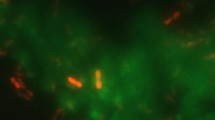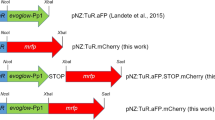Abstract
Lactic acid bacteria (LAB) are commonly used in the production of fermented and probiotic foods. Development of molecular tools to discriminate the strains of interest from the endogenous microbiota in complex environments like food or gut is of high interest. Green fluorescent protein (GFP)-like chromophores strictly requires molecular oxygen for maturation of fluorescence, which restrict the study of microorganisms in low-oxygen environments. In this work, we have developed a noninvasive cyan-green fluorescent based reporter system for real-time tracking of LAB that is functional under anoxic conditions. The evoglow-Pp1 was cloned downstream from the promoters d-alanyl-d-alanine carboxypeptidase and elongation factor Tu of Lactobacillus reuteri CECT925 using pNZ8048 and downstream of the lactococcal P1 promoter using pT1NX. The classical gfp was also cloned in pT1NX. These recombinant expression vectors were electroporated into Lactococccus, Lactobacillus, and Enterococcus strains with biotechnological and/or probiotic interests to assess and compare their functionality under different conditions of oxygen and pH. The expression was analyzed by imaging and fluorometric methods as well as by flow cytometry. We demonstrate that reporter systems pNZ:TuR-aFP and pT1-aFP are two versatile molecular markers for monitoring LAB in food and fecal environments without the potential problems caused by oxygen and pH limitations, which could be exploited for in vivo studies. Production of the fluorescent protein did not disturb any important physiological properties of the parental strains, such as growth rate, reuterin, or bacteriocin production.






Similar content being viewed by others
References
Cogan TM, Barbosa M, Beuvier E, BianchiSalvadori B, Cocconcelli PS, Fernandes I, Gomez J, Gomez R, Kalantzopoulos G, Ledda A, Medina M, Rea MC, Rodriquez E (1997) Characterization of the lactic acid bacteria in artisanal dairy products. J Dairy Res 64:409–421. doi:10.1017/S0022029997002185
Cronin M, Sleator RD, Hill C, Fitzgerald GF, van Sinderen D (2008) Development of a luciferase-based reporter system to monitor Bifidobacterium breve UCC2003 persistence in mice. BMC Microbiol 8. doi:10.1186/1471-2180-8-161
Cubitt AB, Heim R, Adams SR, Boyd AE, Gross LA, Tsien RY (1995) Understanding, improving and using green fluorescent proteins. Trends Biochem Sci 20:448–455. doi:10.1016/S0968-0004(00)89099-4
Chudakov DM, Lukyanov S, Lukyanov KA (2005) Fluorescent proteins as a toolkit for in vivo imaging. Trends Biotechnol 23:605–613. doi:10.1016/j.tibtech.2005.10.005
Daniel C, Poiret S, Dennin V, Boutillier D, Pot B (2013) Bioluminescence imaging study of spatial and temporal persistence of Lactobacillus plantarum and Lactococcus lactis in living mice. Appl Environ Microbiol 79:1086–1094. doi:10.1128/Aem.03221-12
Drepper T, Eggert T, Circolone F, Heck A, Krauss U, Guterl JK, Wendorff M, Losi A, Gartner W, Jaeger KE (2007) Reporter proteins for in vivo fluorescence without oxygen. Nat Biotechnol 25:443–445. doi:10.1038/Nbt1293
Ernst JF, Tielker D (2009) Responses to hypoxia in fungal pathogens. Cell Microbiol 11:183–190. doi:10.1111/j.1462-5822.2008.01259.x
FAO/WHO (2002) Guidelines for the evaluation of probiotics in food. Report of a joint FAO/WHO (Food and Agriculture Organization/World Health Organization) working group on drafting guidelines for the evaluation of probiotics in food. ftp://ftp.fao.org/es/esn/food/wgreport2.pdf
Fernández de Palencia PF, de la Plaza M, Mohedano ML, Martínez-Cuesta MC, Requena T, López P, Peláez C (2004) Enhancement of 2-methylbutanal formation in cheese by using a fluorescently tagged Lacticin 3147 producing Lactococcus lactis strain. Int J Food Microbiol 93:335–347. doi:10.1016/j.ijfoodmicro.2003.11.018
Fernández de Palencia PF, Nieto C, Acebo P, Espinosa M, López P (2000) Expression of green fluorescent protein in Lactococcus lactis. FEMS Microbiol Lett 183:229–234. doi:10.1111/j.1574-6968.2000.tb08963.x
Franz CMAP, Stiles ME, Schleifer KH, Holzapfel WH (2003) Enterococci in foods—a conundrum for food safety. Int J Food Microbiol 88:105–122. doi:10.1016/S0168-1605(03)00174-0
Frese SA, Benson AK, Tannock GW, Loach DM, Kim J, Zhang M, Oh PL, Heng NC, Patil PB, Juge N, Mackenzie DA, Pearson BM, Lapidus A, Dalin E, Tice H, Goltsman E, Land M, Hauser L, Ivanova N, Kyrpides NC, Walter J (2011) The evolution of host specialization in the vertebrate gut symbiont Lactobacillus reuteri. PLoS Genet 7:e1001314. doi:10.1371/journal.pgen.1001314
Gasson MJ (1983) Plasmid complements of Streptococcus lactis NCDO 712 and other lactic streptococci after protoplast-induced curing. J Bacteriol 154:1–9
Geoffroy MC, Guyard C, Quatannens B, Pavan S, Lange M, Mercenier A (2000) Use of green fluorescent protein to tag lactic acid bacterium strains under development as live vaccine vectors. Appl Environ Microbiol 66:383–391. doi:10.1128/AEM.66.1.383-391.2000
Giraffa G (2003) Functionality of enterococci in dairy products. Int J Food Microbiol 88:215–222. doi:10.1016/S0168-1605(03)00183-1
Gory L, Montel MC, Zagorec M (2001) Use of green fluorescent protein to monitor Lactobacillus sakei in fermented meat products. FEMS Microbiol Lett 194:127–133. doi:10.1016/S0378-1097(00)00515-2
Greer 3rd LF, Szalay AA (2002) Imaging of light emission from the expression of luciferases in living cells and organisms: a review. J Lumin 17:43–74. doi:10.1002/bio.676
Guarneri T, Rossetti L, Giraffa G (2001) Rapid identification of Lactobacillus brevis using the polymerase chain reaction. Lett Appl Microbiol 33:377–381. doi:10.1046/j.1472-765X.2001.01014.x
Hansen MC, Palmer RJ, Udsen C, White DC, Molin S (2001) Assessment of GFP fluorescence in cells of Streptococcus gordonii under conditions of low pH and low oxygen concentration. Microbiology-SGM 147:1383–1391
Hutchens M, Luker GD (2007) Applications of bioluminescence imaging to the study of infectious diseases. Cell Microbiol 9:2315–2322. doi:10.1111/j.1462-5822.2007.00995.x
Kishi A, Uno K, Matsubara Y, Okuda C, Kishida T (1996) Effect of the oral administration of Lactobacillus brevis subsp. coagulans on interferon-alpha producing capacity in humans. J Am Coll Nutr 15:408–412. doi:10.1080/07315724.1996.10718617
Klein G (2003) Taxonomy, ecology and antibiotic resistance of enterococci from food and the gastro-intestinal tract. Int J Food Microbiol 88:123–131. doi:10.1016/S0168-1605(03)00175-2
Kuipers OP, de Ruyter PGGA, Kleerebezem M, de Vos WM (1998) Quorum sensing-controlled gene expression in lactic acid bacteria. J Biotechnol 64:15–21. doi:10.1016/S0168-1656(98)00100-X
Landete JM, Peirotén A, Rodríguez E, Margolles A, Medina M, Arqués JL (2014) Anaerobic green fluorescent protein as a marker of Bifidobacterium strains. Int J Food Microbiol 175:6–13. doi:10.1016/j.ijfoodmicro.2014.01.008
Langa S, Landete JM, Martin-Cabrejas I, Rodriguez E, Arques JL, Medina M (2013) In situ reuterin production by Lactobacillus reuteri in dairy products. Food Control 33:200–206. doi:10.1016/J.FOODCONT.2013.02.035
Maruo T, Sakamoto M, Toda T, Benno Y (2006) Monitoring the cell number of Lactococcus lactis subsp cremoris FC in human feces by real-time PCR with strain-specific primers designed using the RAPD technique. Int J Food Microbiol 110:69–76. doi:10.1016/j.ijfoodmicro.2006.01.037
Mazé A, Boël G, Zúñiga M, Bourand A, Loux V, Yebra MJ, Monedero V, Correia K, Jacques N, Beaufils S, Poncet S, Joyet P, Milohanic E, Casaregola S, Auffray Y, Pérez-Martínez G, Gibrat JF, Zagorec M, Francke C, Hartke A, Deutscher J (2010) Complete genome sequence of the probiotic Lactobacillus casei strain BL23. J Bacteriol 192:2647–2648. doi:10.1128/Jb.00076-10
Pérez-Arellano I, Pérez-Martinez G (2003) Optimization of the green fluorescent protein (GFP) expression from a lactose-inducible promoter in Lactobacillus casei. FEMS Microbiol Lett 222:123–127. doi:10.1016/S0378-1097(03)00244-1
Phumkhachorn P, Rattanachaikunsopon P, Khunsook S (2007) Use of the gfp gene in monitoring bacteriocin-producing Lactobacillus plantarum N014, a potential starter culture in nham fermentation. J Food Prot 70:419–424
Reid BG, Flynn GC (1997) Chromophore formation in green fluorescent protein. Biochemistry 36:6786–6791. doi:10.1021/bi970281w
Rodriguez E, Arques JL, Nunez M, Gaya P, Medina M (2005) Combined effect of high-pressure treatments and bacteriocin-producing lactic acid bacteria on inactivation of Escherichia coli O157:H7 in raw-milk cheese. Appl Environ Microbiol 71:3399–3404. doi:10.1128/Aem.71.7.3399-3404.2005
Rodríguez E, Arqués JL, Rodríguez R, Nuñez M, Medina M (2003) Reuterin production by lactobacilli isolated from pig faeces and evaluation of probiotic traits. Lett Appl Microbiol 37(3):259–263. doi:10.1046/j.1472-765X.2003.01390.x
Rodríguez E, Arqués JL, Rodríguez R, Peiroten A, Landete JM, Medina M (2012) Antimicrobial properties of probiotic strains isolated from breast-fed infants. J Funct Foods 4(2):542–551. doi:10.1016/j.jff.2012.02.015
Sambrook JFE, Maniatis T (1989) Molecular cloning: a laboratory manual, 2nd edn. Cold Spring Harbor Laboratory, Cold Spring Harbour
Scott KP, Mercer DK, Glover LA, Flint HJ (1998) The green fluorescent protein as a visible marker for lactic acid bacteria in complex ecosystems. FEMS Microbiol Ecol 26:219–230
Scott KP, Mercer DK, Richardson AJ, Melville CM, Glover LA, Flint HJ (2000) Chromosomal integration of the green fluorescent protein gene in lactic acid bacteria and the survival of marked strains in human gut simulations. FEMS Microbiol Lett 182:23–27. doi:10.1016/S0378-1097(99)00559-5
Schotte L, Steidler L, Vandekerckhove J, Remaut E (2000) Secretion of biologically active murine interleukin-10 by Lactococcus lactis. Enzym Microb Technol 27:761–765. doi:10.1016/S0141-0229(00)00297-0
Stiles ME (1996) Biopreservation by lactic acid bacteria. Anton Leeuw Int J G 70:331–345. doi:10.1007/Bf00395940
Sullivan KF (1999) Enlightening mitosis: construction and expression of green fluorescent fusion proteins. Methods Cell Biol 61:113–135
Tauer C, Heinl S, Egger E, Heiss S, Grabherr R (2014) Tuning constitutive recombinant gene expresion in Lactibacillus plamtarum. Microb Cell Fact 13:150. doi:10.1186/s12934-014-0150-z
Toda T, Kosaka H, Terai M, Mori H, Benno Y, Yamori Y (2005) Effects of fermented milk with Lactococcus lactis subsp cremoris FC on defecation frequency and fecal microflora in healthy elderly volunteers. J Jpn Soc Food Sci Technol 52:243–250
Tsien R (1998) The green fluorescent protein. Annu Rev Biochem 67. doi:10.1146/annurev.biochem.67.1.509
Vanderhoof JA, Whitney DB, Antonson DL, Hanner TL, Lupo JV, Young RJ (1999) Lactobacillus GG in the prevention of antibiotic-associated diarrhea in children. J Pediatr 135:564–568. doi:10.1016/S0022-3476(99)70053-3
Verthé K, Possemiers S, Boon N, Vaneechoutte M, Verstraete W (2004) Stability and activity of an Enterobacter aerogenes-specific bacteriophage under simulated gastro-intestinal conditions. Appl Microbiol Biotechnol 65:465–472. doi:10.1007/s00253-004-1585-7
Walter J, Britton RA, Roos S (2011) Host-microbial symbiosis in the vertebrate gastrointestinal tract and the Lactobacillus reuteri paradigm. Proc Natl Acad Sci U S A 108(Suppl 1):4645–4652. doi:10.1073/pnas.1000099107
Wall T, Roos S, Jacobsson K, Rosander A, Jonsson H (2003) Phage display reveals 52 novel extracellular and transmembrane proteins from Lactobacillus reuteri DSM 20016. Microbiology-SGM 149:3493–3505. doi:10.1099/mic.0.26530-0
Zhang C, Xing XH, Lou K (2005) Rapid detection of a gfp-marked Enterobacter aerogenes under anaerobic conditions by aerobic fluorescence recovery. FEMS Microbiol Lett 249:211–218. doi:10.1016/j.femsle.2005.05.051
Acknowledgments
This work was supported by projects RTA2010-00116-00-00 and RM2012-0004-00-00 from the Spanish Ministry of Economy and Competitiveness (MINECO). J.M. Landete has a postdoctoral contract with the research program “Ramón y Cajal” (MINECO, Spain). The authors thank the valuable help of V. Monedero and M. Zuñiga (Institute of Agrochemistry and Food Technology of the Spanish National Research Council (IATA-CSIC).
Ethical responsibilities
The authors declare that they have followed all the rules of good scientific practice mentioned in the Instructions for authors section of the journal.
Conflict of interest
The authors declare that they have no competing interests.
Author information
Authors and Affiliations
Corresponding author
Electronic supplementary material
Below is the link to the electronic supplementary material.
ESM 1
(PDF 202 kb)
Rights and permissions
About this article
Cite this article
Landete, J.M., Langa, S., Revilla, C. et al. Use of anaerobic green fluorescent protein versus green fluorescent protein as reporter in lactic acid bacteria. Appl Microbiol Biotechnol 99, 6865–6877 (2015). https://doi.org/10.1007/s00253-015-6770-3
Received:
Revised:
Accepted:
Published:
Issue Date:
DOI: https://doi.org/10.1007/s00253-015-6770-3




